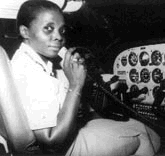
Thérèse Sita-Bella
Encyclopedia

Cameroon
Cameroon, officially the Republic of Cameroon , is a country in west Central Africa. It is bordered by Nigeria to the west; Chad to the northeast; the Central African Republic to the east; and Equatorial Guinea, Gabon, and the Republic of the Congo to the south. Cameroon's coastline lies on the...
ian filmmaker and pilot, and Cameroon
Cameroon
Cameroon, officially the Republic of Cameroon , is a country in west Central Africa. It is bordered by Nigeria to the west; Chad to the northeast; the Central African Republic to the east; and Equatorial Guinea, Gabon, and the Republic of the Congo to the south. Cameroon's coastline lies on the...
's first female journalist
Journalist
A journalist collects and distributes news and other information. A journalist's work is referred to as journalism.A reporter is a type of journalist who researchs, writes, and reports on information to be presented in mass media, including print media , electronic media , and digital media A...
.
She was born into the Beti
Beti-Pahuin
The Beti-Pahuin are a group of related peoples who inhabit the rain forest regions of Cameroon, Republic of the Congo, Equatorial Guinea, Gabon, and São Tomé and Príncipe. Though they separate themselves into several individual ethnic groups, they all share a common history and culture. They were...
tribe in southern Cameroon
Cameroon
Cameroon, officially the Republic of Cameroon , is a country in west Central Africa. It is bordered by Nigeria to the west; Chad to the northeast; the Central African Republic to the east; and Equatorial Guinea, Gabon, and the Republic of the Congo to the south. Cameroon's coastline lies on the...
, and received her education from Catholic missionaries. In the 1950s, after obtaining her baccalaureate from a school in the Cameroonian capital of Yaoundé
Yaoundé
-Transportation:Yaoundé Nsimalen International Airport is a major civilian hub, while nearby Yaoundé Airport is used by the military. Railway lines run west to the port city of Douala and north to N'Gaoundéré. Many bus companies operate from the city; particularly in the Nsam and Mvan neighborhoods...
, she went to Paris
Paris
Paris is the capital and largest city in France, situated on the river Seine, in northern France, at the heart of the Île-de-France region...
in order to continue her studies. It was in France
France
The French Republic , The French Republic , The French Republic , (commonly known as France , is a unitary semi-presidential republic in Western Europe with several overseas territories and islands located on other continents and in the Indian, Pacific, and Atlantic oceans. Metropolitan France...
that her interest in journalism
Journalism
Journalism is the practice of investigation and reporting of events, issues and trends to a broad audience in a timely fashion. Though there are many variations of journalism, the ideal is to inform the intended audience. Along with covering organizations and institutions such as government and...
and in film developed. She returned to Cameroon
Cameroon
Cameroon, officially the Republic of Cameroon , is a country in west Central Africa. It is bordered by Nigeria to the west; Chad to the northeast; the Central African Republic to the east; and Equatorial Guinea, Gabon, and the Republic of the Congo to the south. Cameroon's coastline lies on the...
at the beginning of the 1960s.
In 1963, she created the documentary
Documentary film
Documentary films constitute a broad category of nonfictional motion pictures intended to document some aspect of reality, primarily for the purposes of instruction or maintaining a historical record...
Tam-Tam à Paris which followed a troupe from the National Dance Company of Cameroon during a tour of Paris
Paris
Paris is the capital and largest city in France, situated on the river Seine, in northern France, at the heart of the Île-de-France region...
. It is frequently cited as being the first film by a woman from sub-Saharan Africa
Africa
Africa is the world's second largest and second most populous continent, after Asia. At about 30.2 million km² including adjacent islands, it covers 6% of the Earth's total surface area and 20.4% of the total land area...
. In 1969, Tam Tam à Paris featured at the first Week of African Cinema, a festival which was later to become known as FESPACO.
A feminist who blazed a trail for many other Cameroonian and African women of her generation, she was considered an oddity by the male-dominated system she both defied and worked to become a part of. She once stated:
"Camerawomen in the 1970’s? At that time we were very few. There were few West Indians, a woman from Senegal called Safi FayeSafi FayeSafi Faye is a Senegalese film director and ethnologist. She was the first Sub-Saharan African woman to direct a commercially distributed feature film. She has directed several documentary and fiction films focussing on rural life in Senegal.-Early life and education:Safi Faye was born in 1943 in...
and I. But you know cinema is not a woman's business".
Sita-Bella died on 27 February, 2006, following her admission to hospital. She had been suffering from cancer of the colon, and her death was caused by complications of an operation which had hoped to remove the tumour. Sita-Bella was buried at the Mvolye cemetery in Yaounde
Yaoundé
-Transportation:Yaoundé Nsimalen International Airport is a major civilian hub, while nearby Yaoundé Airport is used by the military. Railway lines run west to the port city of Douala and north to N'Gaoundéré. Many bus companies operate from the city; particularly in the Nsam and Mvan neighborhoods...
.

